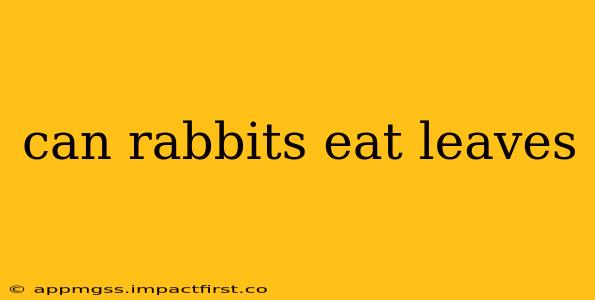Can Rabbits Eat Leaves? A Comprehensive Guide to Safe Leafy Greens for Your Bunny
The question of whether rabbits can eat leaves is a common one among bunny owners. The simple answer is: yes, but with significant caveats. Not all leaves are created equal, and some can be downright toxic to your furry friend. Understanding which leaves are safe and how to introduce them to your rabbit's diet is crucial for their health and well-being.
This guide will delve into the specifics, helping you navigate the leafy landscape and provide your rabbit with a nutritious and safe diet.
What Types of Leaves Can Rabbits Eat?
Rabbits can safely consume many types of leaves, but moderation and proper introduction are key. Safe options include:
- Dandelion greens: These are packed with nutrients and are a favorite among rabbits. Ensure they are pesticide-free.
- Basil: A small amount of fresh basil can be a tasty treat.
- Mint (spearmint and peppermint): Offer sparingly, as too much can cause digestive upset.
- Parsley: A small amount of parsley can be a good addition to their diet.
- Lettuce (Romaine and Red Leaf, in moderation): While some lettuces are fine in small quantities, iceberg lettuce should be avoided entirely due to its low nutritional value.
- Endive and Escarole: These slightly bitter greens can be offered occasionally.
- Watercress: Another nutrient-rich option, but again, moderation is key.
Remember to always wash leaves thoroughly before feeding them to your rabbit to remove any dirt, pesticides, or other harmful substances.
What Types of Leaves Should Rabbits Avoid?
Many common garden plants and leaves are toxic to rabbits and should be avoided completely. These include:
- Rhubarb: Contains oxalic acid, which is toxic to rabbits.
- Azalea and Rhododendron: Highly toxic to rabbits and other animals.
- Ivy: Various types of ivy are toxic.
- Oak leaves: Contain tannins which can cause digestive upset.
- Potatoes (leaves and stems): Contains solanine, which is toxic.
- Tomatoes (leaves and stems): Contain solanine.
- Daffodils, Tulips, Hyacinths: These bulbs and plants are highly toxic.
Always be cautious and research any plant before introducing it to your rabbit's diet. When in doubt, leave it out!
How to Introduce New Leaves to Your Rabbit's Diet?
Introducing new foods to your rabbit's diet should always be done gradually. Start with a very small amount of the new leaf and monitor your rabbit for any signs of digestive upset, such as diarrhea, gas, or lethargy. If you notice any adverse reactions, discontinue feeding the leaf immediately.
Are There Any Benefits to Feeding Rabbits Leaves?
Leafy greens offer various benefits to rabbits:
- Fiber: Essential for healthy digestion.
- Vitamins and Minerals: Provide essential nutrients that contribute to overall health.
- Mental Stimulation: Offering a variety of safe leaves can enrich your rabbit's environment and keep them mentally stimulated.
What About Tree Leaves? Can Rabbits Eat Them?
Many tree leaves are not safe for rabbits to eat, and some are even toxic. It's best to stick to the safe leafy greens listed above and avoid experimentation with tree leaves.
Can Rabbits Eat Dried Leaves?
Dried leaves generally lack the nutritional value of fresh leaves and are not recommended as a significant part of a rabbit's diet. Fresh greens are always preferable.
By following these guidelines and prioritizing the safety of your beloved rabbit, you can incorporate the nutritional benefits of safe leafy greens into their diet, promoting their overall health and happiness. Remember, if you have any concerns, consult with a veterinarian specializing in exotic animals.
